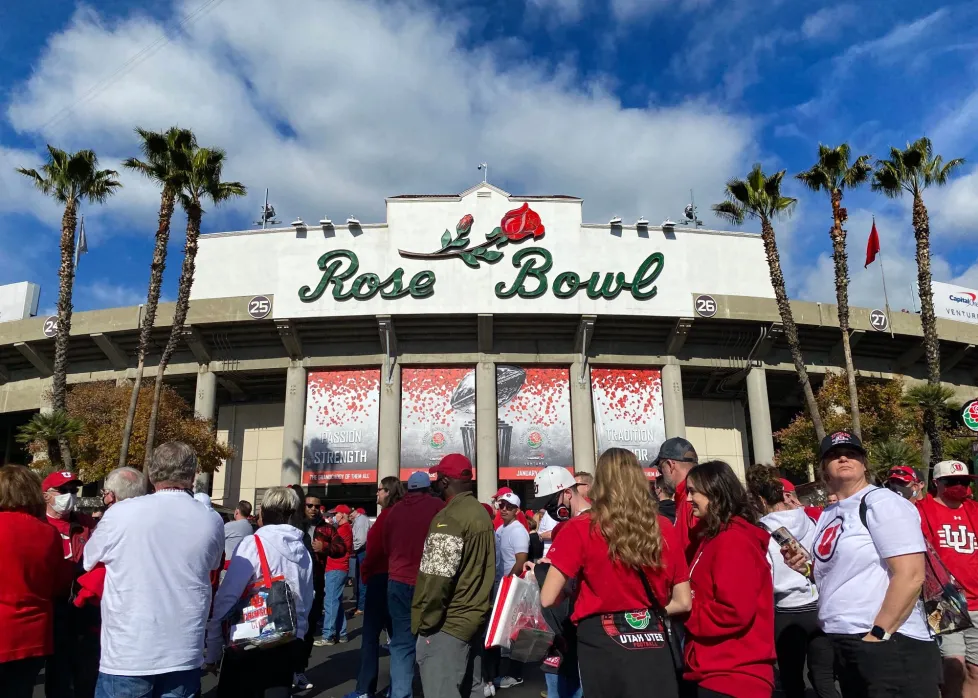Every New Year’s Day, millions of college football fans turn their eyes to Pasadena, California, where one of America’s most beloved sporting traditions unfolds — the Rose Bowl Game. Known as “The Granddaddy of Them All,” the Rose Bowl isn’t just another football match. It’s a celebration of history, community, and the timeless spirit of college athletics.
For over a century, this iconic game has represented the very best of American college football — uniting generations of fans, players, and institutions in a spectacle of competition and pageantry. In this article, we’ll explore the history, traditions, memorable moments, and future of the Rose Bowl Game, as well as what fans can expect in its new era as part of the College Football Playoff system.
What Is the Rose Bowl Game?
The Rose Bowl Game is the oldest bowl game in American college football. It takes place every year on January 1st (or January 2nd when New Year’s Day falls on a Sunday) at the Rose Bowl Stadium in Pasadena, California.
It’s more than a game — it’s a tradition that began in 1902 as part of Pasadena’s Tournament of Roses festivities. Over the years, it has become synonymous with excellence, tradition, and the pride of college sports.
A Historic Beginning
The very first Rose Bowl took place on January 1, 1902, when Michigan defeated Stanford 49–0. The lopsided score discouraged organizers from continuing with football for a while — they replaced it with chariot races for the next 14 years. But in 1916, football returned to stay, and the Rose Bowl Game was officially born.
Since then, it has been played every year without interruption, even through world wars and national crises, symbolizing resilience and continuity.
Tradition and Pageantry: What Makes the Rose Bowl Special
The Tournament of Roses Parade
The Rose Bowl Game is part of a larger New Year’s celebration — the Tournament of Roses Parade. Held earlier in the day, the parade features flower-covered floats, marching bands, and equestrian units parading through the streets of Pasadena.
Millions of spectators line the parade route, while millions more tune in on television. The parade’s theme changes every year, celebrating human creativity and community spirit — setting the perfect tone for the grand football showdown that follows.

The Setting: Rose Bowl Stadium
The Rose Bowl Stadium itself is a legend. Opened in 1922, it’s a National Historic Landmark and one of the most recognized stadiums in the world. With a capacity of over 90,000 fans, it’s seen some of football’s greatest moments — from Super Bowls to World Cup finals and, of course, countless unforgettable college matchups.
There’s something magical about watching the game as the sun sets behind the San Gabriel Mountains, casting a golden glow over the field — a sight so breathtaking that it has become part of American sports folklore.
The Classic Matchup: Big Ten vs. Pac-12
For much of its history, the Rose Bowl Game has featured the champions of the Big Ten Conference and the Pac-12 Conference (formerly the Pacific Coast and Pac-10). This East vs. West rivalry became one of college football’s greatest traditions.
Some of the sport’s most iconic programs — like USC, Ohio State, Michigan, Washington, and Oregon — have made their names on the Rose Bowl stage.
Even as the college football landscape evolves, this matchup remains a symbol of balance between history and competition — representing the best of both coasts and the passion that drives college sports.
The Rose Bowl in the Modern Era
From BCS to College Football Playoff
In 1998, the Rose Bowl joined the Bowl Championship Series (BCS), which occasionally required it to host the national title game instead of its traditional conference champions. Then, in 2014, it became part of the College Football Playoff (CFP), rotating as a semifinal game every three years.
Now, with the expanded 12-team playoff format (starting in 2024–25), the Rose Bowl continues to evolve. Depending on the year, it can host either a quarterfinal or a semifinal — giving fans even more reasons to tune in and celebrate the New Year with football’s finest.
The 2025 Rose Bowl: A New Chapter
The 2025 Rose Bowl Game marked a new era, serving as one of the quarterfinal matchups under the new playoff structure. In this game, Ohio State defeated Oregon 41–21 in a high-scoring clash that lived up to the hype.
What made it even more interesting was that both teams were from the Big Ten Conference, since Oregon had recently joined the conference — a first-of-its-kind scenario for the Rose Bowl. Despite the shift, fans embraced the new format, and the tradition of Pasadena’s New Year’s spectacle continued stronger than ever.
Memorable Moments in Rose Bowl History
The Rose Bowl has seen countless unforgettable games — dramatic comebacks, legendary performances, and defining moments that shaped college football history.
Iconic Games and Performances
- 1902 – The Beginning: Michigan’s 49–0 victory over Stanford set the stage for what would become a century-old tradition.
- 2006 – Texas vs. USC: Widely regarded as one of the greatest college games ever played. Texas quarterback Vince Young led his team to a thrilling 41–38 victory, securing the national championship.
- 2018 – Georgia vs. Oklahoma: In a double-overtime thriller, Georgia triumphed 54–48 in the first-ever CFP semifinal held at the Rose Bowl.
- 2024 – Michigan vs. Alabama: Michigan outlasted Alabama 27–20 in overtime, a defensive showdown that had fans on the edge of their seats.
Each of these games reminds fans why the Rose Bowl is not just another postseason event — it’s a moment in history.
The Fan Experience: More Than Just Football
Pre-Game Festivities
If you’re lucky enough to attend in person, the Rose Bowl offers an unmatched atmosphere. From early morning tailgates to the Rose Bowl Bash and live entertainment, it’s a full-day celebration.
Fans gather in parking lots hours before kickoff, grilling, playing music, and soaking in the California sunshine. The sense of camaraderie is incredible — rival fans often share food, stories, and laughter before the big game.
The Parade and Beyond
The Tournament of Roses Parade sets the festive tone, with stunning floats made entirely of flowers, seeds, and organic materials. After the parade, fans make their way to the stadium, often by foot, creating a wave of color and excitement heading toward the iconic venue.
Inside the Stadium
Once inside, the energy is electric. From the national anthem to the halftime show featuring university marching bands, every moment feels grand. The breathtaking views of the San Gabriel Mountains make it one of the most picturesque sports settings in the world.
The Rose Bowl’s Cultural and National Significance
The Rose Bowl Game represents more than athletic competition — it’s an American institution. Its broadcast reaches millions across the globe, offering a glimpse of U.S. college culture, sportsmanship, and celebration.
For players, it’s often the pinnacle of their college careers — a dream realized. For fans, it’s a shared tradition that marks the beginning of a new year with hope and excitement.
Generations of families gather to watch the game, and alumni proudly wear their school colors, reliving memories and creating new ones each January.
Economic and Community Impact
The Rose Bowl Game is not only a cultural event but also an economic powerhouse for Pasadena and the surrounding region. Each year, the event brings in tens of millions of dollars in tourism revenue.
Hotels, restaurants, and local businesses benefit from the influx of visitors, while the Tournament of Roses Association supports numerous community programs and scholarships.
This powerful combination of sports, community, and charity ensures that the Rose Bowl continues to have a meaningful impact well beyond the field.
The Future of the Rose Bowl Game
As college football evolves, so does the Rose Bowl. With conference realignments, playoff expansions, and media changes, the game continues to adapt — while preserving its traditional spirit.
The move to the 12-team College Football Playoff system ensures that the Rose Bowl will remain a centerpiece event, now with even higher stakes. Whether it’s a quarterfinal or semifinal, it will continue to feature elite programs, passionate fans, and world-class competition.
Despite all the changes, one thing remains certain: the Rose Bowl Game will continue to symbolize the best of college football for decades to come.
Tips for Attending the Rose Bowl Game
If you’re planning to experience the Rose Bowl in person, here are some practical tips:
- Book Early: Tickets and hotels sell out months in advance.
- Arrive Early: Parking lots open as early as 4:00 a.m. for tailgating.
- Use Public Transit: Avoid heavy traffic by using Pasadena’s shuttle services.
- Dress Comfortably: The weather is usually sunny, but mornings can be cool.
- Stay Hydrated: Even in January, California’s sun can be intense.
- Don’t Miss the Parade: It’s part of the full experience — and unforgettable.
Whether you’re watching from the stands or at home, the energy of the Rose Bowl is contagious.
Why the Rose Bowl Still Matters Today
In an age where college football continues to change rapidly, the Rose Bowl Game stands as a comforting constant — a link between past and present.
It’s a reminder that traditions matter, that history shapes identity, and that some things are worth preserving. The game still delivers unforgettable moments, emotional victories, and the perfect start to a new year.
Even as playoffs expand and new teams rise, the Rose Bowl’s unique blend of heritage, competition, and beauty ensures it remains the most cherished stage in college football.
Conclusion
The Rose Bowl Game is far more than just a football contest — it’s a celebration of legacy, teamwork, and the enduring spirit of competition. From its humble beginnings in 1902 to its modern role in the College Football Playoff, it continues to inspire fans and players alike.
Each year, it brings together people from all walks of life to celebrate sport, community, and the promise of a new beginning. Whether you’re there in the stands or watching from your living room, the Rose Bowl reminds us all why we love college football — and why traditions like this one still matter.
So mark your calendar for next January — because when the sun sets over Pasadena and the band plays under a sky of roses, you’ll know you’re witnessing something truly timeless.
